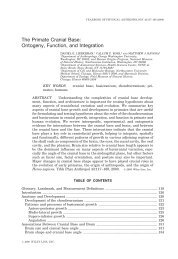—Kurmanji Kurdish— A Reference Grammar with Selected Readings
—Kurmanji Kurdish— A Reference Grammar with Selected Readings
—Kurmanji Kurdish— A Reference Grammar with Selected Readings
You also want an ePaper? Increase the reach of your titles
YUMPU automatically turns print PDFs into web optimized ePapers that Google loves.
KURMANJI KURDISH<br />
sively influenced by Persian, the dominant literary and cultural language of<br />
the area for the last millennium, Kurdish is best approached <strong>with</strong> a knowledge<br />
of Persian, and for that reason reference to Persian syntax has been<br />
freely made throughout the presentation of the grammar.<br />
Sorani has been the second official language of Iraq since the creation of<br />
that country after World War I and has many decades of literary activity<br />
behind it. Kurmanji, which was given its present written form by Jeladet Ali<br />
Bedir-Khan in the early 1930’s, is still far from being a unified, normalized,<br />
or standardized language. For historical and political reasons it has not been<br />
a written means of communication in the largest area in which it is spoken,<br />
and only recently has publication in Kurmanji begun in earnest—and that<br />
mostly among émigré communities in Europe, Sweden in particular. With<br />
the abundance of regional dialects, it is not possible to give a description of<br />
all the variants that may be encountered, although every effort has been<br />
made to describe the main ones that occur in the written language. There<br />
are, for example, regions in which the umlauted ü of Turkish is a regular<br />
feature of the spoken language, but it is not indicated in the writing system.<br />
There are areas in which Kurdish has become so inextricably entangled <strong>with</strong><br />
Turkish and/or Arabic and/or Persian that the grammatical structure of the<br />
language has been affected, while the Kurmanji of former Soviet areas like<br />
Azerbaijan and Armenia, which has been written in Cyrillic letters since the<br />
late 1930’s, has been influenced by Russian. 1 The language described herein<br />
is, to the extent possible, what has been adopted as a norm by the majority<br />
of writers.<br />
The readings, chosen to give samples of a broad range of prose writing,<br />
are provided <strong>with</strong> running vocabulary glosses beneath the texts, and the<br />
glosses in the readings are also contained in the Kurdish–English vocabulary<br />
at the end of the book. Words considered to be absolutely basic vocabulary<br />
are not glossed in the notes, since it is assumed that these words either<br />
are known already or will be actively acquired by looking them up in the<br />
1<br />
Like most regional and ethnic languages of the early Soviet Union that did not<br />
have a traditional alphabet and a long history of literature, Kurmanji was given a<br />
Latin-based alphabet in 1929, but it, like the others, was Cyrillicized by Stalin’s<br />
decree in 1937. Since the collapse of the Soviet Union, Azerbaijan has switched to a<br />
modified Latin alphabet, and it is assumed that the little Kurdish written in Azerbaijan<br />
has followed suit. Kurdish produced in Armenia is now written in both Cyrillic<br />
and a slightly modified form of the normal Latin Kurmanji letters (see the conversion<br />
table for Arabic and Cyrillic on p. 80).<br />
viii

















